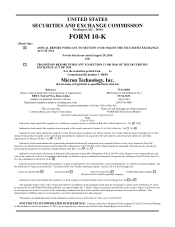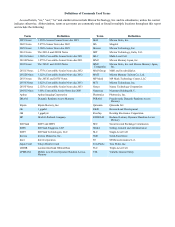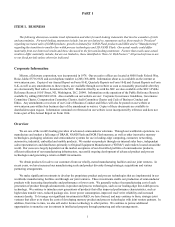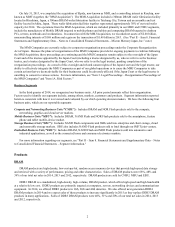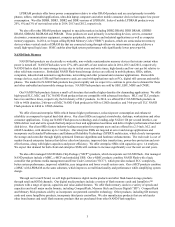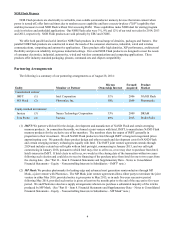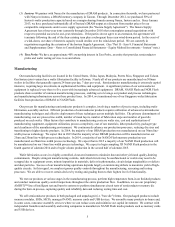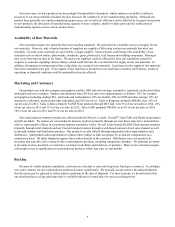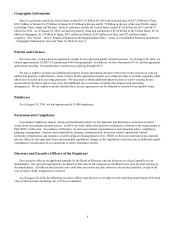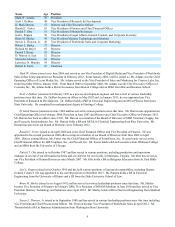Crucial 2014 Annual Report Download - page 7
Download and view the complete annual report
Please find page 7 of the 2014 Crucial annual report below. You can navigate through the pages in the report by either clicking on the pages listed below, or by using the keyword search tool below to find specific information within the annual report.5
(3) Inotera: We partner with Nanya for the manufacture of DRAM products. In connection therewith, we have partnered
with Nanya in Inotera, a DRAM memory company in Taiwan. Through December 2012, we purchased 50% of
Inotera's wafer production capacity based on a margin-sharing formula among Nanya, Inotera and us. Since January
2013, we have purchased substantially all of Inotera's DRAM output at a discount from market prices for our
comparable components under a new supply agreement (the "Inotera Supply Agreement"). The Inotera Supply
Agreement has a three-year term (currently through December 2016) that contemplates annual negotiations with
respect to potential successive one-year extensions. If the parties do not agree to an extension, the agreement will
terminate following the end of the then-existing term plus a subsequent three-year wind-down period. In the event of
a wind-down, our share of Inotera's capacity would decline over the wind-down period. We are currently in
negotiations regarding the extension of the Inotera Supply Agreement. (See "Part II – Item 8. Financial Statements
and Supplementary Data – Notes to Consolidated Financial Statements – Equity Method Investments – Inotera" note.)
(4) Tera Probe: We have an approximate 40% ownership interest in Tera Probe, an entity that provides semiconductor
probe and wafer testing services to us and others.
Manufacturing
Our manufacturing facilities are located in the United States, China, Japan, Malaysia, Puerto Rico, Singapore and Taiwan.
Our Inotera joint venture has a wafer fabrication facility in Taiwan. Nearly all of our products are manufactured on 300mm
wafers in facilities that generally operate 24 hours per day, 7 days per week. Semiconductor manufacturing is extremely capital
intensive, requiring large investments in sophisticated facilities and equipment. A significant portion of our semiconductor
equipment is replaced every three to five years with increasingly advanced equipment. DRAM, NAND Flash and NOR Flash
products share a number of common manufacturing processes, enabling us to leverage our product and process technologies
and manufacturing infrastructure across these product lines. In 2014, we transitioned one of our Singapore wafer fabrication
facilities from production of DRAM to NAND Flash.
Our process for manufacturing semiconductor products is complex, involving a number of precise steps, including wafer
fabrication, assembly and test. Efficient production of semiconductor products requires utilization of advanced semiconductor
manufacturing techniques and effective deployment of these techniques across multiple facilities. The primary determinants of
manufacturing cost are process line-width, number of mask layers, number of fabrication steps and number of good die
produced on each wafer. Other factors that contribute to manufacturing costs are wafer size, cost and sophistication of
manufacturing equipment, equipment utilization, process complexity, cost of raw materials, labor productivity, package type
and cleanliness of the manufacturing environment. We continuously enhance our production processes, reducing die sizes and
transitioning to higher density products. In 2014, the majority of our DRAM production was manufactured on our 30nm line-
width process technology. We expect that in 2015 that the majority of our DRAM production will be manufactured on our
25nm and 20nm line-width process technologies. In 2014, a majority of our NAND Flash memory production was
manufactured on 20nm line-width process technology. We expect that in 2015 a majority of our NAND Flash production will
be manufactured on our 16nm line-width process technology. We expect to begin sampling 3D NAND Flash products in the
fourth quarter of calendar 2014 and to begin volume production in the second half of calendar 2015.
Wafer fabrication occurs in a highly controlled, clean environment to minimize dust and other yield and quality-limiting
contaminants. Despite stringent manufacturing controls, individual circuits may be nonfunctional or wafers may need to be
scrapped due to equipment errors, minute impurities in materials, defects in photomasks, circuit design marginalities or defects
and dust particles. Success of our manufacturing operations depends largely on minimizing defects to maximize yield of high-
quality circuits. In this regard, we employ rigorous quality controls throughout the manufacturing, screening and testing
processes. We are able to recover certain devices by testing and grading them to their highest level of functionality.
We test our products at various stages in the manufacturing process, perform high temperature burn-in on finished products
and conduct numerous quality control inspections throughout the entire production flow. In addition, we use our proprietary
AMBYX™ line of intelligent test and burn-in systems to perform simultaneous circuit tests of semiconductor memory die
during the burn-in process, capturing quality and reliability data and reducing testing time and cost.
We sell semiconductor products in both packaged and unpackaged (i.e. "bare die") forms. Our packaged products include
memory modules, SSDs, MCPs, managed NAND, memory cards and USB devices. We assemble many products in-house and,
in some cases, outsource assembly services where we can reduce costs and minimize our capital investment. We contract with
independent foundries and assembly and testing companies to manufacture NAND Flash media products such as memory cards
and USB devices.

